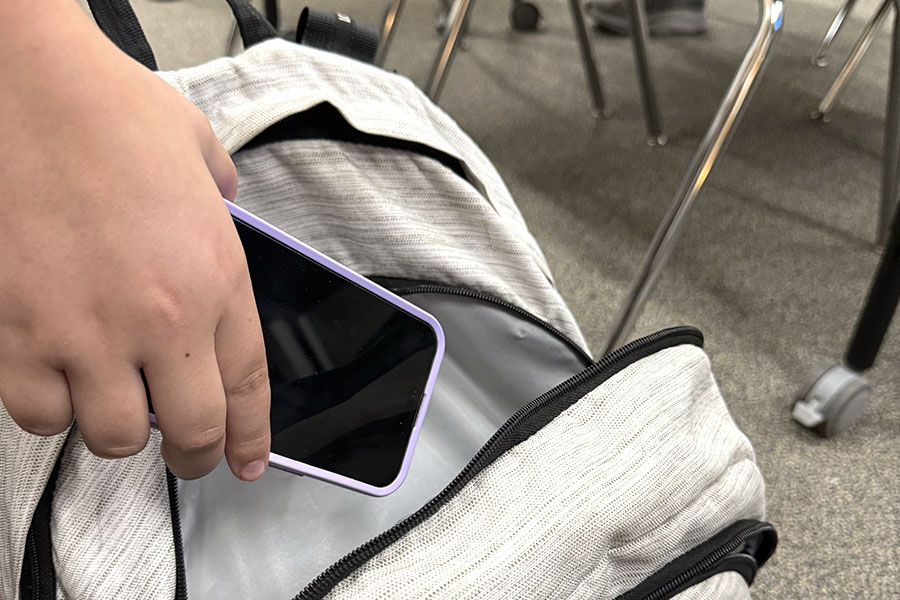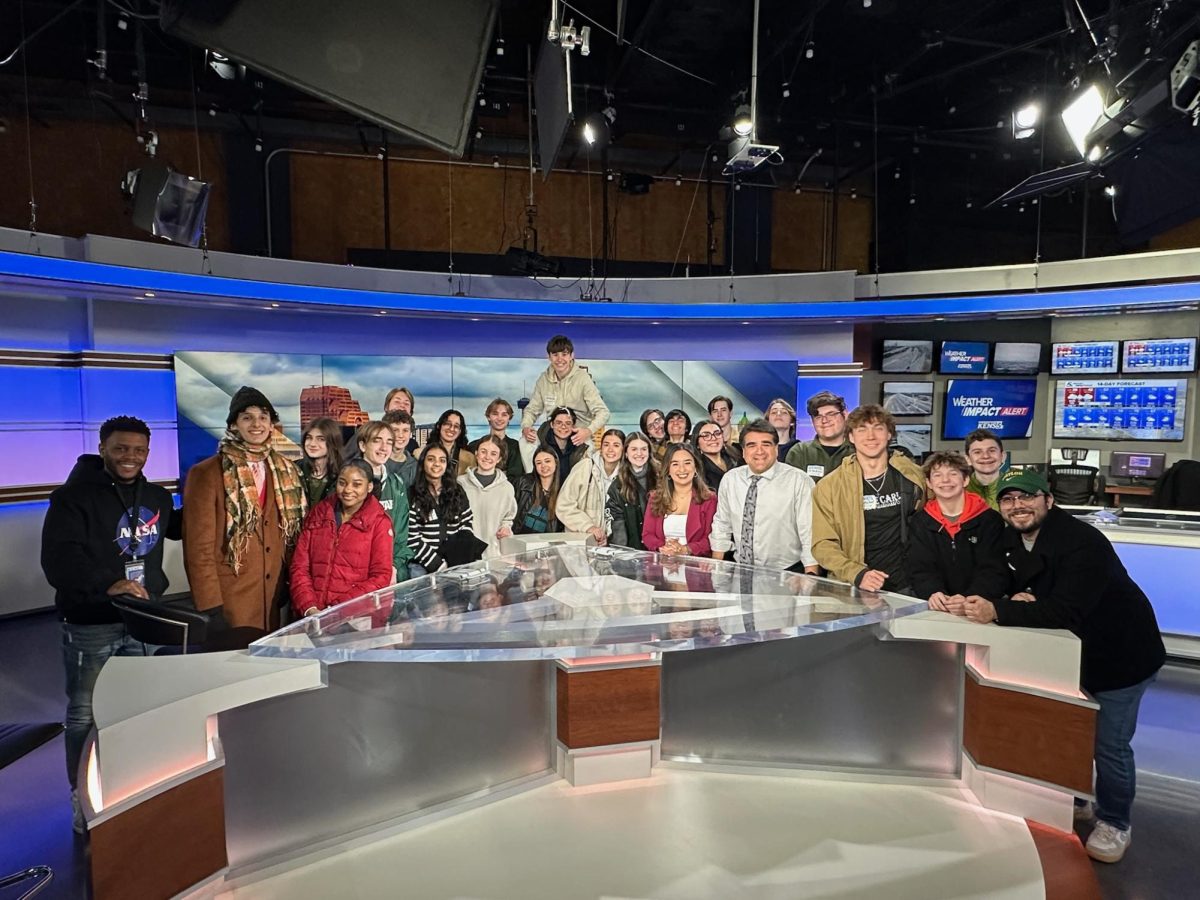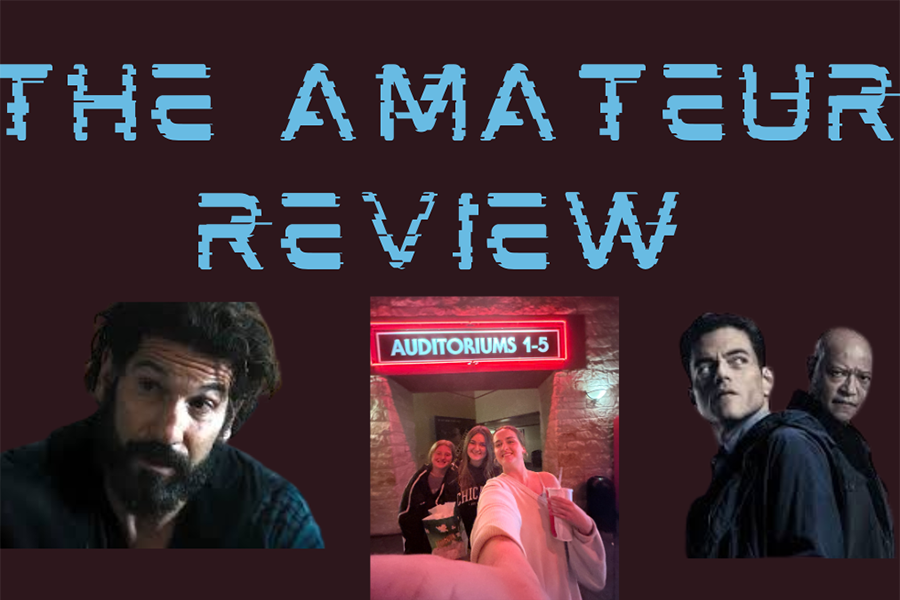Lines? More Like Signs
ASL Students Interpret “A Gentleman’s Guide to Love and Murder”
The implementation of ASL into theatrical performances may enhance the experiences of both deaf and hearing audiences. “[Interpreting is] not even specifically for the Deaf audience, although they are obviously the target audience, I think that a lot of people find the interpreting interesting even if it wasn’t originally in the play,” Eaton said.
January 29, 2020
Musical theatre is an experience consisting of bright lights and intricate costumes in addition to the thrill and personal connection that comes with viewing a live performance. One sensation that may often be taken for granted, however, is the inexplicable presence of sound in these shows. Although one of the defining characteristics of live theatre may be the booming orchestra and captivating lyrics in the musical scores of these performances, this auditory experience is not the same for everyone. In order to make the show enjoyable for all audience members, ASL students took it upon themselves to interpret the musical “A Gentleman’s Guide to Love and Murder” on Jan. 18.
Junior ASL student Grace Eaton was among those interpreting. She said one of the most challenging aspects of preparing to sign was the disconnect between sentence structure and grammar between ASL and English, as well as the quantity of material to retain.
“The memorization is the same as an actor learning their lines, we’re not going to have our scripts just like they are and it’s a lot of lines,” Eaton said. “The grammar is the hardest part because [ASL] works in a different way than English does.”
Similarly, Junior Makayla Kubasiak’s experience with translating, or glossing, the script has been riddled with difficulties unique to the particular show itself in that it takes place in the early 20th century. Gloss is a written form of sign language that makes it easier for English speakers to convert English words and concepts into sign.
“One challenge with interpreting the play is glossing the Old English,” Kubasiak said. “First you have to define unknown words, then you can find the meaning of the lines, and finally find the signs that portray the same meaning. To prepare I continuously sign my parts over and over again. Then, when we go to rehearsals I listen to the characters speak and sign what I practiced [along with them].”
Eaton said that the act of providing ASL interpreting in the musical may enhance the experience not only for deaf audience members but for hearing ones as well.
“[Interpreting is] not even specifically for the Deaf audience, although they are obviously the target audience, I think that a lot of people find the interpreting interesting even if it wasn’t originally in the play,” Eaton said.
Eaton additionally describes what draws her to continue to learn and practice ASL as well as what encouraged her to apply her skills through this theatrical opportunity.
“I like to think of myself as a very dramatic person and I feel like sign language is a very dramatic language,” Eaton said. “I really like the acting aspect, I also love the idea of communicating with more people.”
Kubasiak shares this enthusiasm and finds purpose in the progress she makes as well as the people she impacts by interpreting.
“Signing the play allows those who are deaf or hard of hearing to still enjoy the show and get a similar experience [to other audience members],” Kubasiak said. “Interpreting can definitely be stressful at times but looking back and watching how far you’ve come from when you were first handed the script makes it all worth it.”



![Jumping off the ground, senior linebacker Bennett Patton snatches the ball out of the air for an interception at Thursday’s game against Chaparral. Patton had two interceptions in the 56-14 victory, tying the school record for interceptions in a game. “I was just playing the game,” Patton said. “[I’m] going to go into next week, forget about it and stay humble.” Photo by Harper Chapman](https://cphswolfpack.com/wp-content/uploads/2025/09/bennett-interception.jpg)
![The fire department came to the school after students were evacuated when smoke started coming from the ceiling of a classroom. All students and staff are safe. “All of my friends left their stuff too, so we couldn’t contact our parents, and it was stressful,” senior Brynn Fowler said. “It was scary because I didn’t know [what was going on], and I couldn’t find anyone because it was a big crowd.” Photo by Anthony Garcia](https://cphswolfpack.com/wp-content/uploads/2025/09/firetruck.jpg)


![Sitting with her friend senior Sohpia Struve at last year’s Austin City Limits Festival, senior Ava Zuniga poses for a picture under a pavilion. They are frequent attendees at ACL, an annual music festival at Zilker Park. “I would recommend seeing a bunch of people,” Zuniga said. “This past year, we camped out for Chappell [Roan] for a really long time. I think the whole point of ACL, [which] is a lot of fun, is that you can go see so many different people, even if you don’t know them. So by camping by one person, it really limits yourself from being able to go see a bunch of people.” Photo courtesy of Ava Zuniga](https://cphswolfpack.com/wp-content/uploads/2025/10/EE9E9484-FE6F-4AA0-B5F5-0C177AB32841-1200x857.jpeg)
![Broadcast, yearbook and newspaper combined for 66 Interscholastic League Press Conference awards this year. Yearbook won 43, newspaper won 14 and broadcast took home nine. “I think [the ILPC awards] are a great way to give the kids some acknowledgement for all of their hard work,” newspaper and yearbook adviser Paige Hert said. “They typically spend the year covering everyone else’s big moments, so it’s really cool for them to be celebrated so many times and in so many different ways.”](https://cphswolfpack.com/wp-content/uploads/2025/05/edited-ILPC.jpg)





![Looking down at his racket, junior Hasun Nguyen hits the green tennis ball. Hasun has played tennis since he was 9 years old, and he is on the varsity team. "I feel like it’s not really appreciated in America as much, but [tennis] is a really competitive and mentally challenging sport,” Nguyen said. “I’m really level-headed and can keep my cool during a match, and that helps me play a bit better under pressure.” Photo by Kyra Cox](https://cphswolfpack.com/wp-content/uploads/2025/09/hasun.jpg)

![Bringing her arm over her head and taking a quick breath, junior Lauren Lucas swims the final laps of the 500 freestyle at the regionals swimming competition on date. Lucas broke the school’s 18-year-old record for the 500 freestyle at regionals and again at state with a time of 4:58.63. “I’d had my eye on that 500 record since my freshman year, so I was really excited to see if I could get it at regionals or districts,” Lucas said. “ State is always a really fun experience and medaling for the first time was really great. It was a very very tight race, [so] I was a bit surprised [that I medaled]. [There were] a lot of fast girls at the meet in general, [and] it was like a dogfight back and forth, back and forth.” Photo by Kaydence Wilkinson](https://cphswolfpack.com/wp-content/uploads/2025/03/Kaydence-2.7-23-edit-2.jpg)
![As the support team sits and poses for a photo in the cafeteria with the counseling team they eagerly wait to start their day. "We [all] seem to be a team, I get up every day and there's days where I don't want to go to work today, but I'm thankful that I have a job and I'm blessed to have what I have," Christopherson said. Photo Courtesy of Julie Weltens.](https://cphswolfpack.com/wp-content/uploads/2025/01/AF9E8470-10D7-4C91-BF28-EC8F86BAB66C-1200x852.jpeg)
![As he sprints with the ball, senior running back Trae Hill breaks a tackle during Friday’s 35-14 loss against the Vandegrift Vipers. Hill ran for 135 yards and two touchdowns during the game. “[Scoring] was electric,” Hill said. “It always feels good to score, but the O-line did everything.”](https://cphswolfpack.com/wp-content/uploads/2025/09/IMG_0795allie.varfb_-1200x799.jpg)















![The implementation of ASL into theatrical performances may enhance the experiences of both deaf and hearing audiences. “[Interpreting is] not even specifically for the Deaf audience, although they are obviously the target audience, I think that a lot of people find the interpreting interesting even if it wasn’t originally in the play," Eaton said.](https://cphswolfpack.com/wp-content/uploads/2020/01/Untitled_Artwork.jpg)










![The fire department came to the school after students were evacuated when smoke started coming from the ceiling of a classroom. All students and staff are safe. “All of my friends left their stuff too, so we couldn’t contact our parents, and it was stressful,” senior Brynn Fowler said. “It was scary because I didn’t know [what was going on], and I couldn’t find anyone because it was a big crowd.” Photo by Anthony Garcia](https://cphswolfpack.com/wp-content/uploads/2025/09/firetruck-300x200.jpg)

![Finishing her night out after attending a local concert, senior Grace Sauers smiles at the camera. She recently started a business, PrettySick, that takes photos as well as sells merch at local concert venues. Next year, she will attend Columbia Chicago College majoring in Graphic Design. “There's such a good communal scene because there [are] great venues in Austin,” Sauers said. “I'm gonna miss it in Austin, but I do know Chicago is good, it's not like I'm going to the middle of nowhere. I just have to find my footing again.” Photo Courtesy of Grace Sauers.](https://cphswolfpack.com/wp-content/uploads/2025/04/Grace-300x225.png)


